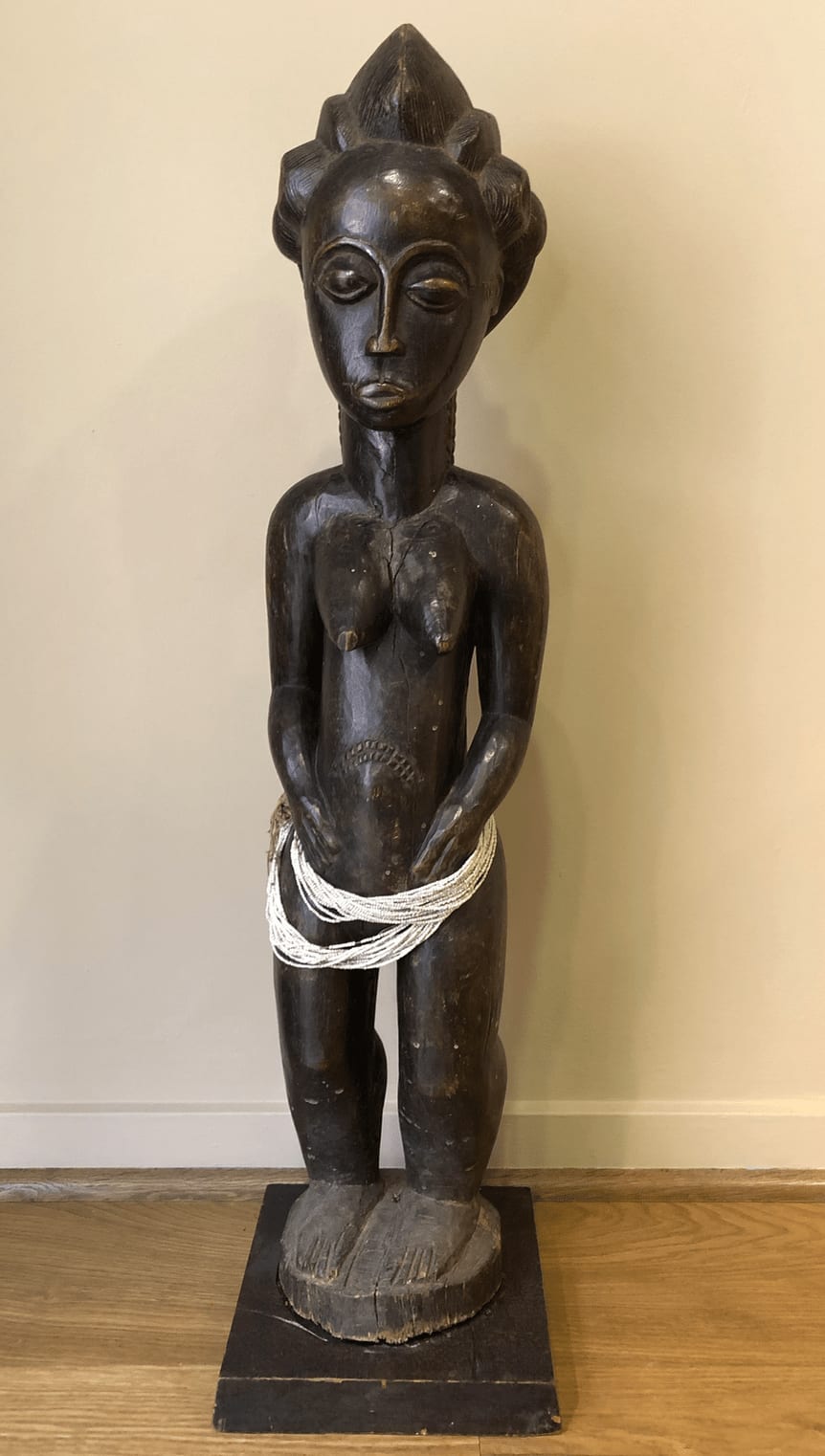Baule Standing Female Figure, Ivory Coast, 1850 CE - 1910 CE
Wood and Beeds
height 87 cm
height 34 1/4 in
height 34 1/4 in
JL.30
Since the first publication of several Baule sculptures in Carl Einstein's seminal book Negerplastik in 1915, Baule art has been at the core of Western appreciation of African art. The...
Since the first publication of several Baule sculptures in Carl Einstein's seminal book Negerplastik in 1915, Baule art has been at the core of Western appreciation of African art. The Baule style is seen as one of the canonic African art traditions and its art historical significance is rivalled only by few other cultures such as the Fang (Gabon), Senufo (Ivory Coast), Kongo (Western DRC) or Luba/Hemba (Eastern DRC).
Susan M. Vogel ( Baule: African Art Western Eyes, New Haven and London, 1997, p. 61) notes: "While the relative naturalism and consummate workmanship of Baule objects were praised at the outset, today these objects are appreciated for their subtle rhythms and a beauty that stops short of sweetness. To the Western eye, an essence of Baule style is a balanced asymmetry that enlivens while suggesting stability and calm. [...] To an art historian, the most consistent feature of Baule art, and one expressed across the wide variety of Baule object types, is a kind of peaceful containment. Faces tend to have downcast eyes and figures often hold their arms against the body, so that Westerners might feel that the mood of much classical Baule art is introspective."
The Baule people believe that every married man and every married woman has their own spiritual partner in the ‘other world’ (in the afterlife, in the ‘bush’, or in the world of spirits). These are called ‘Blolo Bian’ (male) and ‘Blolo Bla’ (female). With these ‘spirit spouses’ in the shape of such figures it is possible to communicate, ask them for advice, discuss problems, etc.
At exactly 34 1/4 in (87 cm) in height, the present Baule Female Statue is of monumental scale and stands firmly on a round plinth. The elongated torso with arms resting on the abdomen, strong calves, beautiful tri-crested coiffure, geometric scarification patterns and the serene facial expression incarnate a physical and moral ideal within Baule society. Discussing a pair of Baule figures from the collection of the Metropolitan Museum of Art, Vogel (1997) elaborates further on this ideal: "Their beautiful [...] coiffures, and their refined scarifications demonstrate their desire to please; their clean, healthy skin, and rounded muscles show they can work successfully, producing food and crafting the things needed by society. At ease in the world, their flexed legs show compressed energy, and the muscular tension of alertness."
Susan M. Vogel ( Baule: African Art Western Eyes, New Haven and London, 1997, p. 61) notes: "While the relative naturalism and consummate workmanship of Baule objects were praised at the outset, today these objects are appreciated for their subtle rhythms and a beauty that stops short of sweetness. To the Western eye, an essence of Baule style is a balanced asymmetry that enlivens while suggesting stability and calm. [...] To an art historian, the most consistent feature of Baule art, and one expressed across the wide variety of Baule object types, is a kind of peaceful containment. Faces tend to have downcast eyes and figures often hold their arms against the body, so that Westerners might feel that the mood of much classical Baule art is introspective."
The Baule people believe that every married man and every married woman has their own spiritual partner in the ‘other world’ (in the afterlife, in the ‘bush’, or in the world of spirits). These are called ‘Blolo Bian’ (male) and ‘Blolo Bla’ (female). With these ‘spirit spouses’ in the shape of such figures it is possible to communicate, ask them for advice, discuss problems, etc.
At exactly 34 1/4 in (87 cm) in height, the present Baule Female Statue is of monumental scale and stands firmly on a round plinth. The elongated torso with arms resting on the abdomen, strong calves, beautiful tri-crested coiffure, geometric scarification patterns and the serene facial expression incarnate a physical and moral ideal within Baule society. Discussing a pair of Baule figures from the collection of the Metropolitan Museum of Art, Vogel (1997) elaborates further on this ideal: "Their beautiful [...] coiffures, and their refined scarifications demonstrate their desire to please; their clean, healthy skin, and rounded muscles show they can work successfully, producing food and crafting the things needed by society. At ease in the world, their flexed legs show compressed energy, and the muscular tension of alertness."
